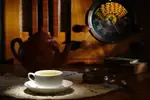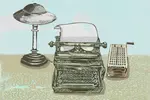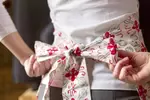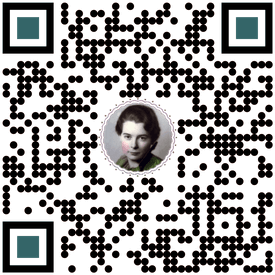- Home
- FUN & Forums
- How to Make Hand Shadows
How to Make Hand Shadows
Learn how to make hand shadows and you will never be at a loss to entertain kids when they're bored or on a camping holiday or when there's nothing to watch on the television. All you need is your hands, a flashlight, and a wall for a screen to display the shadow puppets.
How to Make Hand Shadows for Fun and Entertainment
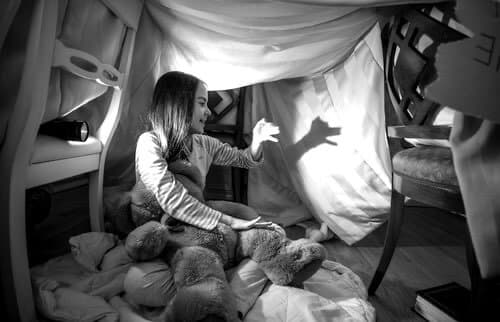 Young Girl Having Fun with Hand Shadows
Young Girl Having Fun with Hand Shadows(Source: ©Kryzhov/Depositphotos.com)
My elderly aunt once shared with me her recollections of a visitor to their farmhouse one evening during the Great Depression of the 1930s.
The young man had come off the railroad tracks begging a meal, and in return he entertained the family by showing them how to make hand shadows.
He sat in front of a coal oil table lamp, and the shadow puppets were skillfully presented on the kitchen wall entertaining the old and young alike.
The old fashioned oil lamps and candles gave off better shadows than today's bright light bulbs that tend to illuminate the entire room and lessen the effect.
Hand shadows, also known as shadow puppetry, have a rich history dating back thousands of years. Originating in China during the Han Dynasty, this art form spread across Asia and eventually to Europe.
It's fascinating to think that something as simple as casting shadows with our hands has captivated people for millennia. There's something magical about creating stories and characters with nothing more than your hands and a light source.
Shadography was a popular amusement throughout the Victorian Era, and it was enjoyed in the early 1900s before electric lighting and newer forms of home entertainment became popular.
It's a reminder of simpler times, before smartphones and tablets dominated our entertainment. Hand shadows tap into our creativity and imagination, allowing us to become storytellers and performers with just a flick of the wrist.
If this classic art form is new to you, then watch the short YouTube video below for a demonstration on how to make shadow animals using only your hands and a small light source.

Making Hand Shadow Puppets
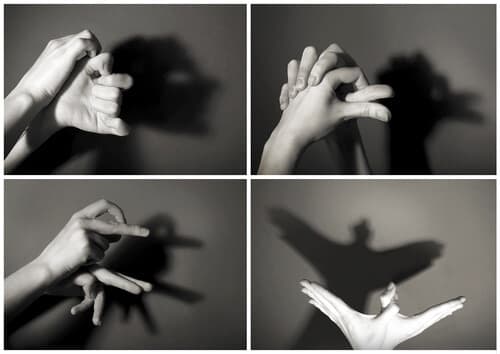 Examples of Hand Shadow Puppets
Examples of Hand Shadow Puppets(Source: ©belchonock/Depositphotos.com)
To create your own hand shadow puppets, start with the basics. Find a blank wall and a light source, like a small lamp, or a flashlight. Position your hands between the light and the wall, about 3 to 4 feet away from the wall. Experiment with different hand shapes and movements to create various animals and objects.
As you practice, you'll discover that subtle adjustments can make a big difference. The angle of your hands and the distance from the light source can contribute to bringing your shadow puppets to life. Don't be afraid to add sound effects or voices to enhance your performance.
The Light Source
The sharpest shadows come from a small, bright light source. A single lighted candle was favored by the Victorians, but a small flashlight, or a small 5-watt appliance bulb in a lamp can be used to good effect.
Just keep in mind that the light source must be small yet bright enough to throw a clearly defined shadow in the darkened room.
The Screen
Use a white or light-colored wall for the screen. A white sheet hung over a door can serve the same purpose. As an alternative, a white sheet can be suspended in an open doorway to permit the audience to sit in a darkened room in front of the screen while the performer remains in the room behind the screen with the light source.
How to Make Hand Shadows by Félicien Trewey
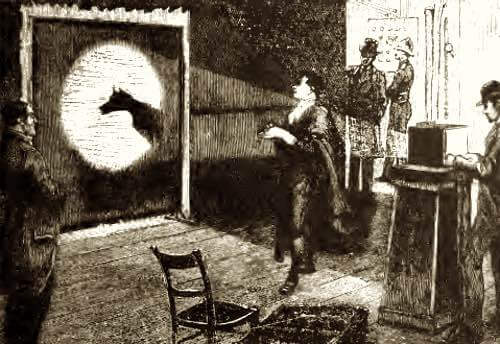 Félicien Trewey Performing the Shadowgraph
Félicien Trewey Performing the Shadowgraph(Source: Open Court Magazine, 1904)
One of the greatest performers of Shadowgraphy was the French entertainer Félicien Trewey (1848-1920). He learned how to make hand shadows as an art form, and he perfected many popular hand shadow animals that other entertainers copied and added to their acts.
Though greatly skilled in mime, balancing objects, and legerdemain, the "shadowgraph" in Trewey's performance surprised and amused most. His amazing measure of dexterity was described as "Treweyism."
"The Art of Shadowgraphy: How It Is Done" was published around the time of Trewey's death, and it contains a wealth of instruction for anyone wanting to learn how to make hand shadows. The how-to illustrations and instructions below are excerpted from Trewey's book:
How to Make Hand Shadow Puppets
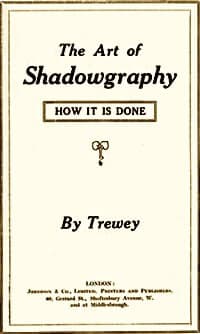 Shadowgraphy
ShadowgraphyThe following eight positions of the hand and fingers being exercised, will give to the beginner very valuable assistance. Figs. 1-8 below.
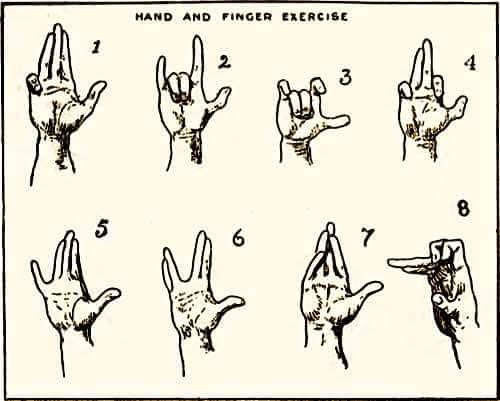 Hand and Finger Exercise by Trewey
Hand and Finger Exercise by TreweyThe most convenient distance of the light from the hands is four feet, and about six feet from the hands to the wall or screen on to which the shadows are to be thrown.
It will often be found necessary, in order to gain a desirable effect, to turn the hands a little to the right or to the left.
The amateur should be careful to cover any mirror in the room which would reflect the light and cause two shadows.
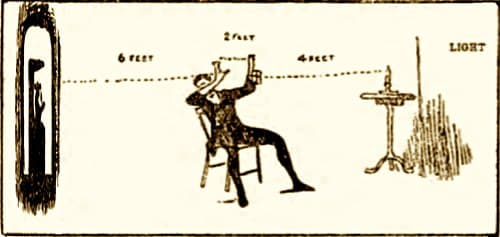 How to Make Hand Shadow Puppets by Trewey
How to Make Hand Shadow Puppets by TreweyFig 9 — The Rabbit. Many works have been produced to explain and illustrate "Shadows on the Wall," and almost invariably have begun with a rabbit. If there be any who do not know how to perform this, a glance at the illustration will suffice to instruct.
Fig. 10 — The Swan.
Figs. 11 and 12 — The Wolf was performed by Campi and Frizzo, but...
 The Rabbit, the Swan, and the Wolf by Trewey
The Rabbit, the Swan, and the Wolf by TreweyFig. 13 — The Elephant, and
Fig. 14 — The Bird, and
Fig. 15 — The Cat, were perfected by Trewey.
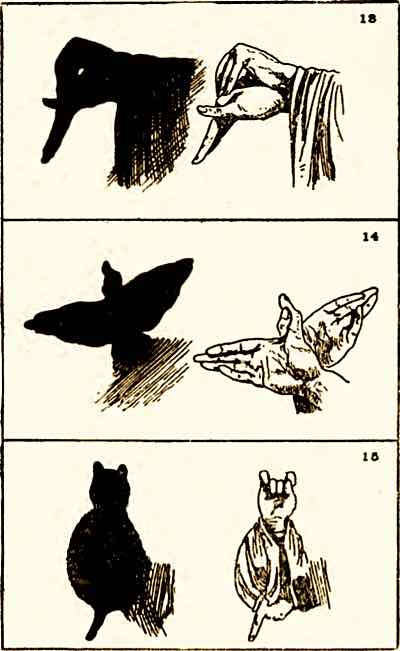 The Elephant, the Bird, and the Cat by Trewey
The Elephant, the Bird, and the Cat by TreweyFig. 16 — The Old Man
Fig. 17 — Perfect Nose
Fig. 18 — The Countryman, and
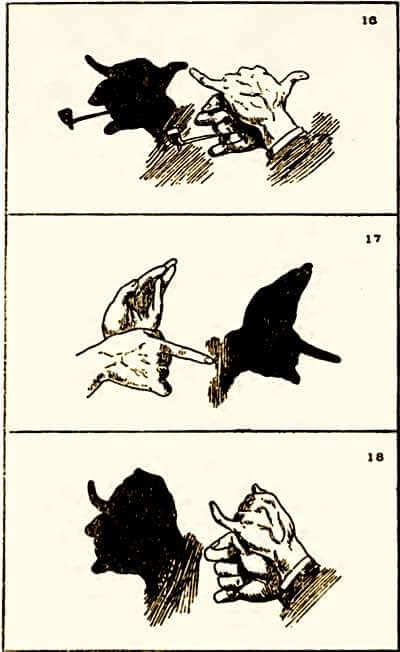 The Old Man, Perfect Nose, and the Countryman by Trewey
The Old Man, Perfect Nose, and the Countryman by TreweyFig. 19 — The Grimacer had been performed by others, but
Fig. 20 — The Volunteer, and
Fig. 21 — Robinson Crusoe were Trewey's inventions.
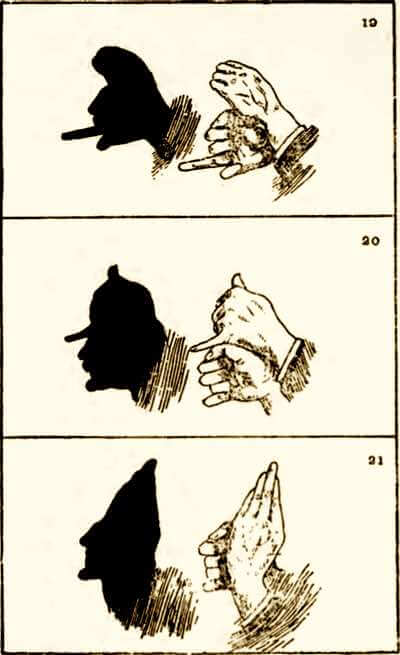 The Grimacer, the Volunteer, and Robinson Crusoe by Trewey
The Grimacer, the Volunteer, and Robinson Crusoe by TreweyFig. 22 — The Jockey, and
Fig. 23 — The Rope Dancer were invented by Trewey during a visit to the Alhambra (a palace, fortress complex located in Granada, Andalusia, Spain).
 The Jockey and the Rope Dancer by Trewey
The Jockey and the Rope Dancer by TreweyAt the same time,
Fig. 24 — The Boatman, and
Fig. 25 — The Fisherman were first produced.
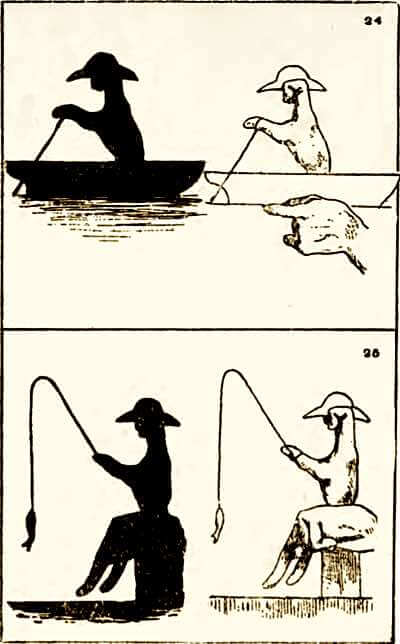 The Boatman and the Fisherman by Trewey
The Boatman and the Fisherman by TreweyFig. 26 — The perfection of the Preacher.
Fig. 26a — Shews the mode by which the Preacher is performed.
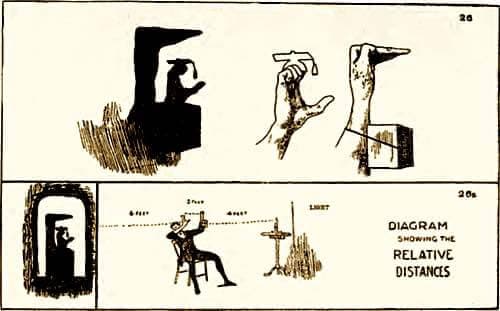 The Perfection of the Preacher, and the Performance by Trewey
The Perfection of the Preacher, and the Performance by TreweyThe Animated Pantomime
Fig. 27 — The Policeman is the "follower" of the servant girl. He knocks at the door, and the girl appears at the upstairs window, and after an exchange of compliments, the girl withdraws herself from the window and reappears at the door.
She gives to the policeman a drink from the bottle; and he, after wiping his beard, kisses her and retires.
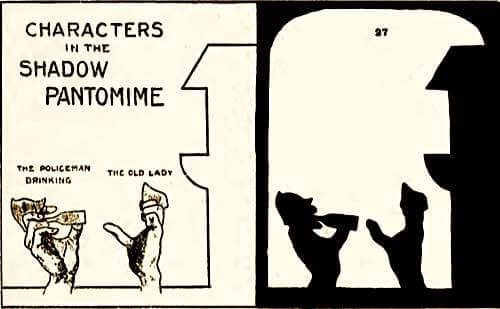 The Girl and the Policeman Pantomime by Trewey
The Girl and the Policeman Pantomime by TreweyFactoid
The Paterfamilias was the oldest male in a household, the head of a Roman family.
Fig. 28 — Then comes the itinerant musician, playing a doleful air upon the clarinet. Paterfamilias comes to the bedroom window, and motions the player away, but the musician derisively strikes up a lively tune, and Paterfamilias now makes his appearance armed with a long broom with which he thrashes him.
The musician still persisting, Paterfamilias next produces the water jug and pours the contents upon the head of the luckless serenader who quickly makes his exit.
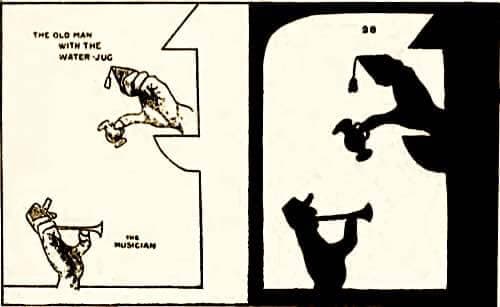 The Musician and Paterfamilias Pantomime by Trewey
The Musician and Paterfamilias Pantomime by TreweyIt will be noticed that the little accessories, such as the helmet for the policeman, the broom, etc., are little articles which may easily be cut from pasteboard, and, where necessary, attached to the figures by means of an India-rubber ring fastened to the properties.
The water jug, however, must be an actual little vessel in order to contain sand, which when poured out, gives all the appearance of a flow of water.
The amateur, with perseverance, can achieve all the results set forth in this book, and with a little ingenuity may possibly invent others, and the amusement afforded will prove ample repayment for his labor.
How to Make Hand Shadows by Henry Bursill
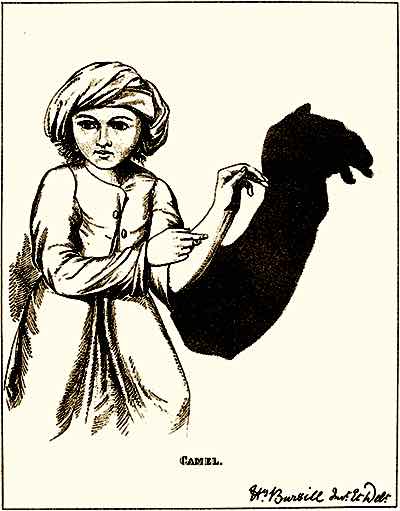 Hand Shadow of a Camel by Henry Bursill
Hand Shadow of a Camel by Henry Bursill(Source: Hand Shadows by Bursill, 1859)
Henry Wayte Bursill (1833-1871) studied at London's Royal Academy of Arts from 1854 to 1863 and became a noted sculptor, medalist, and modeller.
Shadowgraphy was Bursill's longtime amusement and in 1859, he published "Hand Shadows to be Thrown Upon the Wall," a small book that featured a series of his original designs. In the preface, he wrote the following:
"Some of my sketches were made years ago, others when a student at the Academy. Indeed, the Shadows have often been displayed on the walls of my studio, much to the amusement of fellow-students who would, I am sure, at any time bear witness to their originality."
If you love the art of shadowgraphy, you will love Bursill's book. It includes a collection of illustrations that reveal how to form figures of animals, birds, and people simply by using your hands to cast shadows.
Download Hand Shadows
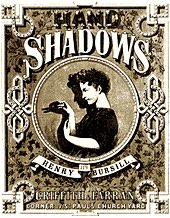
Get secure instant access to your FREE PDF COPY of Henry Bursill's 21-page book Hand Shadows that you can download and print out for easy reading.

Sign Up now for GRANDMA'S DESSERT CLUB and download your FREE PDF COPY of Grandma McIlmoyle's Little Dessert Book. Also receive my regular Bulletin featuring classic recipes and nostalgia.
